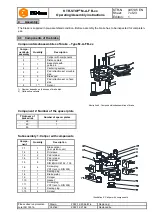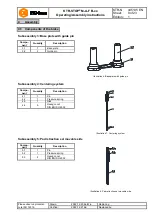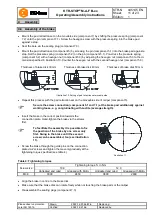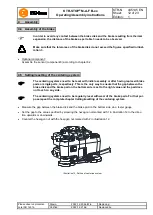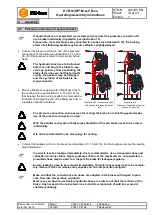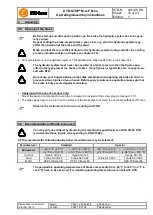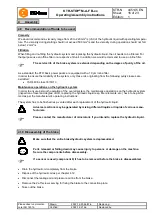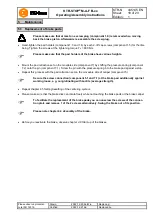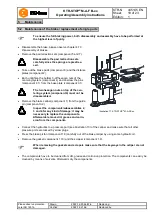
KTR-STOP
®
M-A-F B-xx
Operating/Assembly instructions
KTR-N
Sheet:
Edition:
445145 EN
15 of 23
1
Please observe protection
note ISO 16016.
Drawn:
2022-12-20 Ka/Wie
Replacing:
Verified:
2022-12-21 Ka
Replaced by:
Before start-up and after each operation on the brake the hydraulic system has to be gene-
rally vented.
Repeat venting the brake several times a year, since any air in the hydraulic system may
affect the operation of the brake and the plant.
!
Make sure that there is sufficient liquid in the hydraulic system during and after the venting
process (recommendation of liquid, see chapter 4.10).
•
Put some pressure on the hydraulic system. This will allow the brake pads to fit on the brake disk.
!
The hydraulic system must never be operated at a higher pressure than the figures spe-
cified in the type plate of the brake or table 1. If any figures or types/sizes are changed, con-
sult with KTR.
!
Never keep your fingers between brake disk and brake when applying the brake in order to
prevent serious injuries of your hands. Before every maintenance operation make sure that
the brake is fully secured against activating.
•
Applying with the use of a sensor only:
Mount the sensor (component 8) according to chapter 6.2 instead of the screw plug (component 1.11).
•
The brake pads have to be run in on the surface of the brake disk to achieve the nominal coefficient of friction.
Observe the instructions for run-in according to KTR-N.
!
You may only use mineral hydraulic liquids meeting the specifications of DIN 51524. KTR
recommends those liquids corresponding to DIN 51524-3.
KTR recommends the following liquids (other manufacturers may be selected):
Manufacturer
Standard
Special
Mineral oil
-20 °C to +40 °C
(-4 °F to +104 °F)
+ 10 °C to + 60 °C
(+ 50 °F to + 140 °F)
-30 °C to +20 °C
(-22 °F to +68 °F)
+ 30 °C to + 70 °C
(+ 86 °F to + 158 °F)
Castrol
Hyspin HVI 32
Hyspin HVI 46
-
Hyspin HVI 68
Shell
Tellus S2 VX32
Tellus S2 VX46
Tellus S4 VX32
Tellus S2 VX68
Mobil
DTE 10 Excel 32
DTE 10 Excel 46
-
DTE 10 Excel 68
The permissible operating temperatures of brake components from -20 °C to +60 °C (-4 °F to
+140 °F) have to be observed. For deviating operating temperatures consult with KTR.
4
Assembly
4.8 Start-up of the brake
4.9 Recommendation of fluids to be used







